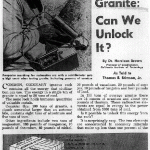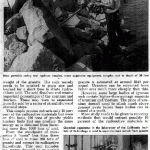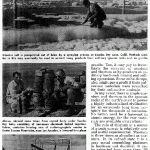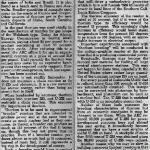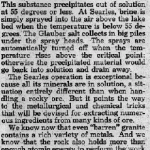THERE’S ATOMIC ENERGY IN GRANITE: CAN WE UNLOCK IT?
Common, ordinary igneous rock contains all the energy that civilization can use. The energy in a single ton of granite is equal to 50 tons of coal. The same rock holds immense quantities of valuable metals.
Consider this: 100 tons of granite, a chunk somewhat larger than an automobile, contains eight tons of aluminum and five tons of iron. Other ingredients include two tons of magnesium, 180 pounds of manganese, 70 pounds of chromium, 40 pounds of nickel, 30 pounds of vanadium, 20 pounds of copper, 10 pounds of tungsten and four pounds of lead.
In 100 tons of average granite there are 14 ounces of uranium and about two pounds of thorium. These radioactive elements are equal in energy to the power obtained from 5000 tons of coal.
Is it possible to unlock this energy from the rock?
It is surprisingly easy. The two elements are concentrated in accessory minerals that make up less than one percent of the weight of the granite. The rock merely needs to be crushed to gain size and leached for a short time in dilute hydrochloric acid. The acid dissolves and retains important percentages of the uranium and thorium. These may than be separated from the acid by a series of straightforward chemical steps.
This simple process extracts only 25% of the radioactive materials but even on this basis, 100 tons of granite yields nuclear fuels that can produce the same energy as is obtained from burning more than 1000 tons of coal.
From the standpoint of energetics it “costs” less than three tons of coal to mine 100 tons of granite and extract its radioactive ingredients. This cost includes the power devoted to quarrying the rock, crushing it, disposal of wastes, transportation, acids, water pumping, shop facilities and other considerations. Thus, by burning three tons of coal one gets a profit, in energy, amounting to 997 or more tons of coal.
In dollars and cents the picture is not as bright. The price of producing uranium from average granite is estimated at around $340 per pound. Uranium can be extracted from richer ores much more cheaply than this.
However, some large bodies of igneous rock contain higher-than-average amounts of uranium and thorium. The price of uranium doesn’t need to climb much above present levels before these bodies can be mined at a profit.
More study needs to be given to recovery methods that would extract possibly 80% of the radioactive materials in granite. Too, it may pay to investigate the recovery of uranium and thorium as by-products in ordinary hard-rock mining and milling operations. Some mine dumps, also, might pay a profit if their pulverized materials were reworked for their radioactive contents.
In any event, there is ample uranium and thorium in the igneous rocks of the earth’s crust to power a highly industrialized civilization for an extremely long time, certainly for thousands of centuries. No nation need be a have-not in atomic energy, for the raw materials are available everywhere.
The role of thorium as a source of atomic energy is relatively new and is still experimental. Thorium is three times as abundant as uranium. In its refined state it is a gray metal resembling platinum in hardness and ductility. It can be extracted form more than 100 different minerals. One source of thorium is the colored glassy monazite particles in granite.
The radioactivity of granite, as a matter of fact, has led to much confusion on the part of week-end prospectors. Prowling the hills with a geiger counter, an amateur prospector is apt to be elated when he gets a high count form a body of granite or decomposed granite. He’s sure he has made a rich strike. Sometimes it is hard to convince him that granite is virtually worthless at present, even though it is a storehouse that we will tap in the future.
Monazite, the chief commercial source of thorium today, is mined as a beach sand on the coasts of India and Brazil. It is also found as a beach sand in Russia and Australia. Smaller quantities of monazite sand occur in the coasts of Florida and Oregon. Other sources of thorium are in the rare earth deposits of Idaho, South Carolina and California.
In the past thorium was used chiefly in the manufacture of mantles for gas lamps of the Welsbach type. Today the Atomic Energy Commission is buying small amounts paying about $4 per pound for a product containing at least 30% thorium oxide. After reducing this to a metal, the AEC offers it for use in experimental reactors at a price of around $19 per pound. Until recently the thorium was refined into metal by an expensive hatch process that required costly reagents. Now a semi continuous process, much less expensive, has been worked out.
Thorium is not readily fissionable. It does not maintain a chain reaction as do U-235 and plutonium. It is a raw material for atomic energy, rather than being an atomic fuel in itself.
When bombarded by neutrons, thorium changes into uranium 233, and U-233 can maintain a chain reaction. This explains the importance of thorium.
Thorium is to be used in experimental “breeder” reactors that are intended to produce power and at the same time to create as much nuclear fuel as they consume. In theory, a breeder can produce as much as 115% of the fuel it burns up, though this may not prove true in practice. Even if a breeder reactor produces almost as much fuel, it still represents a big step in the development of energy.
Such a breeder would have a central core in which U-235 or some other atomic fuel is burned. The thorium will be placed like a blanket around the core so that it captures some of the neutrons that the core emits. The U-233 that is thus created from the thorium in turn will emit more neutrons, transmuting additional thorium. The theory is that a breeder reactor will maintain itself as long as new supplies of thorium are fed to it.
It may be that thorium reactors can operate at higher temperatures than are permissible with other kinds. The resulting increase in efficiency would produce more steam.
This summer a sodium-graphite reactor using enriched U-238 was being completed near Los Angeles by Atomics International, a division of North American Aviation. Heat from the reactor will create steam that will drive a turboelectric generator which in turn will furnish 7500 kilowatts of power to local lines of the Southern California Edison Company.
The thermal efficiency of the reactor is rated at 30%, but if it were the thorium type its efficiency would be around 33%. This seemingly slight increase in efficiency would boost steam temperature from the present 825 degrees to as much as 950 degrees, with an appreciable increase in electrical output.
Important experiments concerned with “thorium breeding” will be conducted in the sodium-graphite reactor at the same time that it is producing commercial power.
Eventually, thorium may become the favored raw material for fueling all large central atomic-power stations. This may not happen for some time, especially in the United States where rather large quantities of the uranium isotope 238 are on hand.
For every pound of fissionable U-235 that is refined, more than 200 pounds of U-238 are automatically obtained. This isotope can be converted into plutonium by bombardment, and plutonium can be used as a nuclear fuel. Too, U-238 that is enriched with U-235 is an acceptable atomic fuel.
Neither of this fuels possesses the breeding characteristics of thorium but from an economic standpoint it may be cheapest to use them. When the AEC released 88.000 pounds of U-235 for power development purposes here and abroad this past spring, it immediately became apparent that we have a vast surplus of useful U-238 on hand. A stockpile of more than 6000 tons of U-238 was obtained when the 88.000 pounds of U-235 were refined.
Another reason why we may be slow in building numerous thorium reactors is that we don’t possess rich deposits of thorium. On the other hand, India is greatly interested in using thorium for power because of the deposits of thorium it possesses.
The usual tendency in any mining operation is to work the richest deposit first. Another tendency is to extract only one or two of the most valuable ingredients from an ore and literally to throw all the rest of the mineral on the dump. Eventually, as our richest mineral resources are used up, it will become standard practice to extract as many as 20 or 30 products from any one mining and milling operation.
In a few unique cases this is being done today. American Potash & Chemical Corporation extracts more than 20 chemicals from the brine that it pumps from alkaline deposits lying under Searles Dry Lake in California. Among other products taken from the brine are table salt, salt cake that is used in fertilizers, soda ash for glass and washing compounds, borax, sodium phosphate, sodium bromide and lithium chloride.
These and other chemicals are removed from the brine in a series of distillation and precipitation steps. Some of these steps are complicated, some are extremely simple. One worth mentioning is the way that Glauber salt is extracted from the brine. This substance precipitates out of solution at 55 degrees or less. At Searles, brine is simply sprayed into the air above the lake bed when the temperature is below 55 degrees. The Glauber salt collects in big piles under the spray heads. The sprays are automatically turned off when the temperature rises above the critical point; otherwise the precipitated material would go back into solution and drain away.
The Searles operation is exceptional because all its minerals are in solution, a situation entirely different than when handling a rocky ore. But it points the way to the metallurgical and chemical tricks that will be devised for extracting numerous ingredients from many kinds of ore.
We know now that even “barren” granite contains a rich variety of metals. And we know that the rock also holds more than enough atomic energy to perform the work of extracting the metals, with energy left over. The time when we will be mining granite may be a long way off, yet it is interesting to speculate on what our resources will be when that time does come.
Suppose that a few centuries from now the United States becomes much more industrialized than it is at present. Suppose, too, that industry in all other parts of the world rises to the same high level. By then, the world population may well have grown to 30 billion persons.
Such a population might consume rock for tis metals and atomic fuels at the rate of 1500 billion tons per year.
Would we soon run out of rock? Hardly. Assuming that all the land areas were available for such processing, man would “eat” his way downward at the rate of less than one tenth inch per year!

